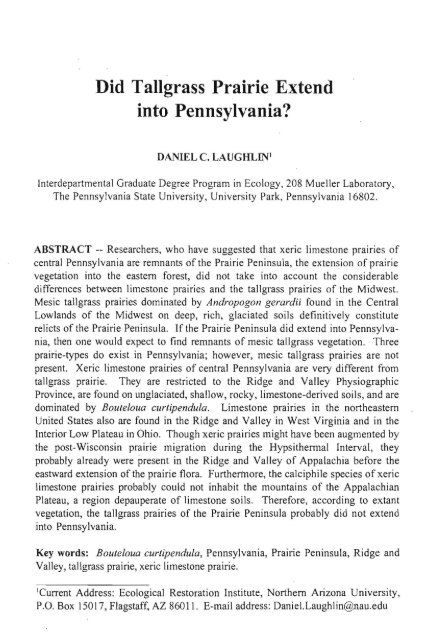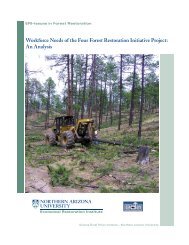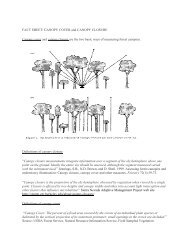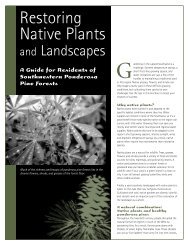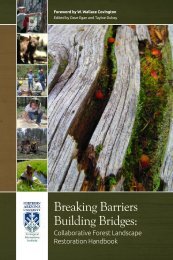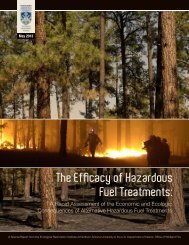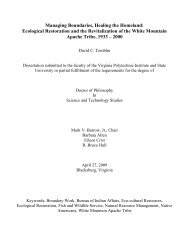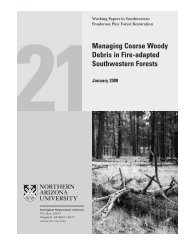Did Tallgrass Prairie Extend into Pennsylvania? - ERI Library ...
Did Tallgrass Prairie Extend into Pennsylvania? - ERI Library ...
Did Tallgrass Prairie Extend into Pennsylvania? - ERI Library ...
You also want an ePaper? Increase the reach of your titles
YUMPU automatically turns print PDFs into web optimized ePapers that Google loves.
<strong>Did</strong> <strong>Tallgrass</strong> <strong>Prairie</strong> <strong>Extend</strong><strong>into</strong> <strong>Pennsylvania</strong>?DANIEL C. LAUGHLIN)Interdepartmental Graduate Degree Program in Ecology, 208 Mueller Laboratory,The <strong>Pennsylvania</strong> State University, University Park, <strong>Pennsylvania</strong> 16802.ABSTRACT -- Researchers, who have suggested that xeric limestone prairies ofcentral <strong>Pennsylvania</strong> are remnants of the <strong>Prairie</strong> Peninsula, the extension of prairievegetation <strong>into</strong> the eastern forest, did not take <strong>into</strong> account the considerabledifferences between limestone prairies and the tallgrass prairies of the Midwest.Mesic tallgrass prairies dominated by Andropogon gerardii found in the CentralLowlands of the Midwest on deep , rich, glaciated soils definitively constituterelicts of the <strong>Prairie</strong> Peninsula. If the <strong>Prairie</strong> Peninsula did extend <strong>into</strong> <strong>Pennsylvania</strong>,then one would expect to find remnants of mesic tallgrass vegetation. Threeprairie-types do exist in <strong>Pennsylvania</strong>; however, mesic tall grass prairies are notpresent. Xeric limestone prairies of central <strong>Pennsylvania</strong> are very different fromtallgra ss prairie. They are restricted to the Ridge and Valley PhysiographicProvince, are found on unglaciated, shallow, rocky, limestone-derived soils, and aredominated by Bouteloua curtipendula. Limestone prairies in the northeasternUnited States also are found in the Ridge and Valley in West Virginia and in theInterior Low Plateau in Ohio. Though xeric prairies might have been augmented bythe post-Wisconsin prairie migration during the Hypsitherrnal Interval, theyprobably already were present in the Ridge and Valley of Appalachia before theeastward extension of the prairie flora . Furthermore, the calciphile species of xericlimestone prairies probably could not inhabit the mountains of the AppalachianPlateau, a region depauperate of limestone soils. Therefore, according to extantvegetation, the tallgrass prairies of the <strong>Prairie</strong> Peninsula probably did not extend<strong>into</strong> <strong>Pennsylvania</strong>.Key words: Bouteloua curtipendula, <strong>Pennsylvania</strong>, <strong>Prairie</strong> Peninsula, Ridge andValley, tallgrass prairie, xeric limestone prairie.'Current Address: Ecological Restoration Institute, Northern Arizona University,P.O. Box 15017, Flagstaff, AZ 86011. E-mail address: Daniel.Laughlin@nau.edu
12The <strong>Prairie</strong> Naturalist 36(1): March 2004E. Lucy Braun (1955) wrote. "The unusual. rather than the usual, has attractedattention . and often proves of great value when reconstructing past events".Howe\er. the "unusual" xeric limestone prairies of <strong>Pennsylvania</strong> have receivedlittle attention amidst the great forests of Central Appalachia (Laughlin and Uhl2003). Plant communities unlike those of the surrounding and dominant vegetationare often regarded as "remnants of a time when the type of vegetation which theyrepresent \\';s more widespread, or perhaps dominant" (Braun 1928a). Remnantcommunities have become surrounded by an "advancing flora" and according toGleason (1923):"It is entirely beyond the limits of probability or coincidence to presume thata dozen or more species, normally growing together in one section of thecountry. should also be found together in another remote section beyond thenormal limits of dispersal of any of them. Isolated colonies of this character.....can have but one significance, that at some time in the past thesecolonies were more numerous and separated by narrow intervals within thenormal migration-capacity of the species, or were entirely continuous overthe whole area."There are 10 known xeric limestone prairies in <strong>Pennsylvania</strong>. They are small (noneexceed 0.3 ha), scattered, and have declined by 48% over the past century(Laughlin 2003, Laughlin and UhI2003). Some scholars have postulated that theseprairies represent remnants of a former extension of mesic tallgrass prairie <strong>into</strong>central <strong>Pennsylvania</strong> (Losensky 196I, Waltman and Ciolkosz 1995).Typical prairie plants are found naturally in <strong>Pennsylvania</strong>. A review of Ladd(1997) and Rhoads and Klein (1993) revealed that 52% (509 of988) of the species inLadd's list of tallgrass prairie plants are native to <strong>Pennsylvania</strong>, and 25% (126 of509) of these native <strong>Pennsylvania</strong> prairie species are listed as endangered orthreatened in <strong>Pennsylvania</strong>. Moreover, 25% (509 of 2076) of all plant speciesnative to <strong>Pennsylvania</strong> also are found in the tallgrass prairie. Therefore, one couldargue that the tallgrass prairie might once have existed in presettlement Pennsylvarua.The <strong>Prairie</strong> Peninsula (Transeau 1935) was "the wedge-shaped or peninsulalikeprojection of prairie vegetation (or prairie biota) extending from the prairiegrasslands eastward <strong>into</strong> the deciduous forest" (Stuckey 1981). Transeau (1905,1935) used climatic, paleoclimatic, and ecological features of the region to suggestthe location of the easternmost extension of the tallgrass prairie. Transeau (1935)mentioned prairie floras in northwestern <strong>Pennsylvania</strong> (he did not cite an exampleand his map does not include any locations in <strong>Pennsylvania</strong>), possibly referring to"blazing star prairies", as evidence of the possible extent of tallgrass vegetation<strong>into</strong> <strong>Pennsylvania</strong>. Most importantly, however, Transeau (1905) suggested thatthe 100% ratio of rainfall to' potential evaporation boundary line lies in western<strong>Pennsylvania</strong>. Also, average midsummer relative humidity in <strong>Pennsylvania</strong>matched humidity levels in the rest of the <strong>Prairie</strong> Peninsula (Transeau 1935).
Laughlin: <strong>Prairie</strong>s in <strong>Pennsylvania</strong>13Therefore, the eastern boundary of climatic conditions that could allow for prairie/savanna dominance was in western <strong>Pennsylvania</strong> and that the climate east (andnorth and south) of this boundary was suitable for the eastern deciduous forest.Most scholars suggest that the grasslands of the <strong>Prairie</strong> Peninsula reachedpeak distribution during a time of global drought, known as the HypsithermalInterval (8000 to 4000 YBP), when the western species more adapted to dry climatesmigrated toward the east (Stuckey 1981, Webb et al. 1983, Baskin et a!. 1994). Amore recent warm and dry period known as the "Medieval Warm Period" or"Medieval Climatic Optimum" also occurred globally and locally in North Americafrom ca. A.D. 900 to 1300 (Brush 1991, Luckman 1994). This period has beenassociated with more frequent wild fires (Brush 1991) and the development of oak(Quercus spp.) savannas (Nuzzo 1985). During cooler and wetter times, thegrassland has been colonized by forest, but research strongly suggested that manylarge remnants throughout the Midwestern states persisted because of a frequentfire regime (Gleason 1923, Pyne 1987, Heikens and Robertson 1994). Therefore, noclear and simple relationship has been shown to exist between climate and thedistribution of grassland because other factors, such as fire and grazing animals,played significant and integral roles (Anderson 1982).The easternmost extension of the <strong>Prairie</strong> Peninsula is disputed, but manyscholars have drawn the boundary in central or eastern Ohio based on extantrelicts of tallgrass vegetation (Gray 1878, Adams 1902, Braun 1921, Gleason 1923,Schaffner 1926, Braun 1928a, 1928b, 1950, Anderson 1983). The easternmostbluestem prairie in Kuchler's (1964) map of potential natural vegetation of theUnited States was in west-central Ohio; <strong>Pennsylvania</strong> was composed almostentirely of Appalachian oak (Quercus spp.) and Northern Hardwood forests. Also,Delcourt and Delcourt (1981) did not show any type of grassland community in<strong>Pennsylvania</strong> in their vegetation maps for eastern North America from 40,000 YBPto the present. Today, however, <strong>Pennsylvania</strong> hosts three distinct prairie-types.These are the "blazing star prairies" of western <strong>Pennsylvania</strong> (Jennings 1939,Aaron 1974), the serpentine barrens and grasslands of the Piedmont Province (Fike1999, Tyndall and Hull 1999), and the xeric limestone prairies (sensu Baskin et a!.1994 and Baskin and Baskin 2000) of the Ridge and Valley Physiographic Province(Laughlin and Uhl 2003).The Big Barrens of Kentucky and Tennessee once was considered part ofthe <strong>Prairie</strong> Peninsula by Transeau (1935), but Baskin and Baskin (1981) andBaskin et al. (1994) used geological, edaphic, botanical, and paleobotanical datato determine that it was not part of the <strong>Prairie</strong> Peninsula. Transeau's (1905,1935) analysis of climatic data suggested that the <strong>Prairie</strong> Peninsula also mighthave extended <strong>into</strong> <strong>Pennsylvania</strong>. If the <strong>Prairie</strong> Peninsula did extend <strong>into</strong><strong>Pennsylvania</strong>, then one would expect to find remnants of mesic tallgrassvegetation. Through reviews of the literature I examined the plant speciescomposition and abiotic conditions of prairie communities throughout Pennsyl
Laughlin: <strong>Prairie</strong>s in <strong>Pennsylvania</strong> 15Figure 1. Locations of three prairie-types in <strong>Pennsylvania</strong>. Light gray areas arePhysiographic Provinces, drawn from Fenneman (1928), that contain a prairie-type.Stars represent the "blazing star prairies" in the unglaciated region of theAppalachian Plateau (Aaron 1974), circles represent the xeric limestone prairies inthe Ridge and Valley (Laughlin and Uhl 2003), and triangles represent theserpentine barrens on the Piedmont (Reed 1986, Tyndall and Hull 1999).codominant and Schizachyrium scoparium is also common on a few sites.Anemone virginiana , Solidago nemoralis, Monarda fistulosa, Lithospermumcanescens, Asclepias tuberosa, A. verticillata, A. viridiflora, Penstemon hirsutus,and Packera obovata are some of the most frequently found forbs on these sites(Laughlin and Uhl 2003) . Eleven species found on these prairies are listed in<strong>Pennsylvania</strong> as endangered, threatened, or of special concern. These species arethe following: An emone cylindrica, Bromus kalmii, Unum sulcatum,Lithospermum canescens, Onosmodium molle var. hispidissimum, Ophioglossumengelmannii, Dichanthelium oligosanthes, Ranunculus jascicularis, Ruelliahumilis, Cassia marilandica, and Oligoneuron rigidum , The limestone prairies arerestricted to south-southwest facing slopes within the valleys of the Ridge andValley and are found on shallow, rocky, and slightly alkaline limestone-derived,clay loam soils (Laughlin and Uhl 2003).
Laughlin: <strong>Prairie</strong>s in <strong>Pennsylvania</strong> 17small patches of prairie might become invaded completely by drought toleranteastern redcedar (Juniperus virginian a) and other woody species (Laughlin, InPress).The xeric limestone prairies of <strong>Pennsylvania</strong> are very similar to the limestoneprairies in the Ridge and Valley of West Virginia (Bartgis 1993) and these both bearresemblance to the Schizachyrium scoparium-Bouteloua curtipendula prairies insouthern Ohio on the Interior Low Plateau (Fig. 2) (Braun 1928a, I928b, 1951 , 1955).All three of these prairie associations have rather similar species compositions andedaphic conditions and occur on unglaciated soils.Bouteloua curtipendula was the most abundant grass in the limestoneprairies of <strong>Pennsylvania</strong> (Laughlin and Uhl 2003) and West Virginia (Bartgis 1993)within the Ridge and Valley and the second most abundant grass in the limestoneprairies of Ohio (Table I). Schizachyrium scopariu m, the most abundant grass inthe limestone prairies of Ohio, also was found in the limestone prairies of<strong>Pennsylvania</strong>, but to a limited extent.The limestone prairies of the Ridge and Valley and of Ohio were all found onxeric calcareous soils (Braun 1928b, Bartgis 1993, Laughlin and Uhl 2003). TheSchizachyrium scoparium-Bouteloua curtip endula prairie remnants of Ohio occurredon "the uppermost Silurian formations of the Cedarville and Monroedolomites" (Braun 1928b), and flora dominated by Bouteloua curtipendula in<strong>Pennsylvania</strong> occurred on limestone-derived soils. Braun (1928b) described theOhio prairie soils as "very stony ... so much so as to suggest a gravel soil". Soils ofthe limestone prairies in <strong>Pennsylvania</strong> were also extremely rocky, often withexposed limestone bedrock at the surface (Laughlin and Uhl 2003). Rocky soilscontributed solely to limestone prairie maintenance at present (Laughlin, In Press).Braun (1928b) stated that under these dry edaphic conditions "water supply wouldapproach that of a region of lower rainfall [so that] the abundant stored supply ofan evenly distributed annual rainfall so necessary for development of a deciduousforest is not present". In contrast, soils of tallgrass prairie remnants in theMidwest are generally deep, rich loarns (Braun 1928b).Another similarity between Ohio and Ridge and Valley limestone prairies isthat neither lies in the zone of Wisconsin glaciation (Table I). Braun (1928a, 195I)was the first to describe these xeric prairies south of the glacial border and sheattributed their uniqueness to an earlier origin. Some scholars argued they wererelated to the post-Wisconsin Xerothermic extension of prairie <strong>into</strong> Ohio (seeStuckey 198I), but Braun (I 928a, 1951) determined these xeric prairie remnants to bepre-Illinoian in age (greater than 300,000 YBP) because they were not found onglacial till in the Central Lowlands .but were in the distinct, unglaciated region ofthe Interior Low Plateau (Fig. 2). The prairies in the glacial till deposited byWisconsin glaciers were mesic grasslands dominated by Andropogon gerardii,"the typical eastern expression of prairie in the prairie-deciduous forest transitionregion" (Braun 1928a). However, neither the Schizachyrium scoparium-Bouteloua
Laughlin: <strong>Prairie</strong>s in <strong>Pennsylvania</strong> 19probably dispersed north through the Ridge and Valley from the south-centralstates because they could not have traversed east over the mountains of theAppalachian Plateau, a region depauperate of limestone soils (Laughlin 2003).Therefore, according to extant vegetation the tallgrass prairies of the <strong>Prairie</strong>Peninsula probably did not extend <strong>into</strong> <strong>Pennsylvania</strong>.ACKNOWLEDGMENTSJ thank Jeffrey Gerwing , Christopher Uhl, and Eric Post for their helpfulcomments on early drafts of this manuscript.LITERATURE CITEDAaron, 1. 1974. Blazing star prairies of western <strong>Pennsylvania</strong>. Published by theauthor, Butler, <strong>Pennsylvania</strong> .Adams, C. C. 1902. Postglacial origin and migrations of the life of the northeasternUnited States. Journal of Biogeography 1:303-310, 352-357.Anderson, R. C. 1982. An evolutionary model summarizing the roles of fire,climate, and grazing animals in the origin and maintenance of grasslands: anend paper. Pp. 297-308 in Grasses and grasslands : systematics and ecology(J. E. Estes, R. L. Tyrl, and J. N. Brunken, editors). University of OklahomaPress, Norman, Oklahoma.Anderson, R. C. 1983. The eastern prairie-forest transition- an overview. Pp. 86-92in Proceedings of the Eighth North American <strong>Prairie</strong> Conference (R. Brewer,editor). Western Michigan University, Kalamazoo, Michigan.Anonymous. 1996. A recreational guide for Jennings Environmental EducationCenter. A pamphlet by the <strong>Pennsylvania</strong> Department of Conservation andNatural Resources, Harrisburg, <strong>Pennsylvania</strong>.Bartgis, R. L. 1993. The limestone glades and barrens of West Virginia. Castanea58:69-89.Baskin, J. M., and C. C. Baskin. 1981. The Big Barrens of Kentucky not part ofTranseau's <strong>Prairie</strong> Peninsula . Pp. 43-48 in The <strong>Prairie</strong> Peninsula-in the"shadow" of Transeau. Proceedings of the Sixth North American <strong>Prairie</strong>Conference (R. L. Stuckey and K. J. Reese, editors). Ohio Biological SurveyBiological Notes No. 15.Baskin, J. M., and C. C. Baskin. 2000. Vegetation of limestone and dolomite gladesin the Ozarks and Midwest regions of the United States. Annals of theMissouri Botanical Garden 87:286-294.
20ril e <strong>Prairie</strong> Natu ralist 36( 1): Ma rc h 2004Baskin. J. M.. C. C. Baskin. and E. W. Chester. 1994. The Big Barrens region ofKentucky and Tennessee: further observations and considerations. Castanea59:226-25-l.Bazzaz. F. A.. and J. A. D. Parrish. 1982. Organization of grassland communities.Pp. 233-254 ill Grasses and grasslands: systematics and ecology (J. E. Estes,R. L. Tyrl. and 1. N. Brunken. editors). Universityof Oklahoma Press. Norman,Oklahoma.Braun. E. L. 192 1. Composition and source of the flora of the Cincinnati [Ohio]region. Ecology 2:161- J80.Braun. E. L. \928a. Glacial and post-glacial plant migrations indicated by reliccolonies of southern Ohio. Ecology 9:284-302.Braun. E. L. 1928b. The vegetation of the Mineral Springs Region of AdamsCounty. Ohio. Ohio Biological Survey Bulletin No. 15. 3:375-517.Braun. E. L. 1950. Deciduous forests of eastern North America. Hafner PublishingCompany, New York, New York.Braun, E. L. 1951. Plant distribution in relation to glacial boundary. Ohio Journalof Science5\ :139-\46.Braun, E. L. \955. The phytogeography of unglaciated eastern United States andits interpretation. Botanical Review 21:297-375.Brush, G. S. 1991. Stratigraphic history helps us understand today's ChesapeakeBay. Geotimes 36:21 -23.Delcourt, P. A., and H. R. Delcourt. 1981. Vegetation maps for eastern NorthAmerica: 40,000 yr BP to the present. Pp. 123-166 in Geobotany. II (R.Romans, editor). Plenum Press, New York, New York.Fenneman, N. M. 1928. Physiographic divisions of the United States. Annals ofthe Association of American Geographers 18:261-353.Fike, J. 1999. Terrestrial and palustrine plant communities of <strong>Pennsylvania</strong>.Bureau of Forestry, <strong>Pennsylvania</strong> Department of Conservation and NaturalResources, Harrisburg, <strong>Pennsylvania</strong>.Gleason, H. A. \923. The vegetational history of the Middle West. Annals of theAssociation of American Geographers 12:39-85.Gray, A. 1878. Forest geography and archeology. American Journal of Science116:85-94, \83-\96.Heikens, A. L., and P. A. Robertson. 1994. Barrens of the midwest: a review of theliterature. Castanea 59:184-194.Jennings, O. E. 1939. Contributions toward a plant geography of western<strong>Pennsylvania</strong>. Trillia 10:47-81.KUch ler, A. W. 1964. Potential natural vegetation of the conterminous UnitedStates. Map and accompanying manual. American Geographical Society,Special Publication No. 36.
Laughlin: <strong>Prairie</strong>s in <strong>Pennsylvania</strong>21Ladd, D. 1997. Vascular plants of midwestern tallgrass prairies. Pp. 351-399 in Thetallgrass restoration handbook : for prair ies, savannas , and · woodlands (S.Packard and C. F. Mutel , editors). Island Press, Washington, District ofColumbia.Laughlin, D. C. 2003. Geographic distribution and dispersal mechanisms ofBouteloua curtipendula in the Appalachian Mountains. American MidlandNaturalist 149:268-281 .Laughlin, D. C. In Press. Woody plant invasion and the importance ofanthropogenic disturbance in xeric limestone prairies. Journal of the<strong>Pennsylvania</strong> Academy of Science.Laughlin, D. C, and C. F. Uhl. 2003. The xeric limestone prairies of <strong>Pennsylvania</strong> .Castanea 68:300-3I6.Lindestrom , P. M. 1925. Geographia Americae (translated by A. Johnson) .Swedish Colonial Society, Philadelphia, <strong>Pennsylvania</strong>.Losensky, J. 1961. The great plains of central <strong>Pennsylvania</strong>. M. S. Thesis, The<strong>Pennsylvania</strong> State University, University Park, <strong>Pennsylvania</strong>.Luckman, B. H. 1994. Evidence for climatic conditions between ca. 900-1300 A.D.in the southern Canadian Rockies. Climatic Change 26: 171-182.Myers, R. L., and P. A. Peroni . 1983. Approaches to determining aboriginal fire useand its impact on vegetation. Bulletin of the Ecological Society of America64:217-218.Nuzzo, V. A. 1985. Extent and status of Midwest oak savanna: presettlement and1985. Natural Areas Journal 6:6-36.Ostrander, S. 2000. Great natural areas of western <strong>Pennsylvania</strong>. Stackpole Books,Mechanicsburg, <strong>Pennsylvania</strong>.Pyne, S. 1. 1987. These conflagrated prairies : a cultural fire history of thegrasslands. Pp. 131-137 in The prairie: past and future. Proceedings of theNinth North American <strong>Prairie</strong> Conference (G. K. Clambey and R. H. Pemble,editors) . North Dakota State University. Tri-College University Center forEnvironmental Studies. Fargo, North Dakota .Reed, C. F. 1986. Floras of serpentine formations in eastern North America, withdescriptions of geomorphology and mineralogy of the formations. ReedHerbarium, Baltimore, Maryland.Rhoads, A. F., and T. A. Block. 2000. The plants of <strong>Pennsylvania</strong>: an illustratedmanual. University of <strong>Pennsylvania</strong> Press, Philadelphia, <strong>Pennsylvania</strong>.Rhoads, A. F., and W. M. Klein, Jr. 1993. The vascular flora of <strong>Pennsylvania</strong>:annotated checklist and atlas . American Philosophical Society, Philadelphia,<strong>Pennsylvania</strong>.Russell, E. W. B. 1983. Indian-set fires in the forests of the northeastern UnitedStates. Ecology 64:78-88.
22The <strong>Prairie</strong> N aturalist 36( 1): Marc h 2004Schaffner, J. H. 1926. Observations on the grasslands of the central United States.Ohio State University Studies Contributions in Botany No. 178: I-56.Stuckey, R. L. 1981. Origin and development of the concept of the prairiepeninsula. Pp. 4-23 in The prairie peninsula-in the "shadow" of Transea u.Proceedings of the Sixth North American <strong>Prairie</strong> Conference CR. L. Stuckeyand K. J. Reese, editors). Ohio Biological Survey Biological Notes No. 15.Transeau, E. N. 1905 . Forest centers of eastern North America. AmericanNaturalist 39:875-889.Transeau, E. N. 1935. The prairie peninsula. Ecology 16:423-437.Tyndall, R. W., and J. C. Hull. 1999. Vegetation, flora, and plant physiologicalecology of serpentine barrens of eastern North America. Pp. 67-82 inSavannas, barrens, and rock outcrop communities of North America (R. C.Anderson, J. S. Fralish, and J. M. Baskin, editors). Cambridge UniversityPress, Cambridge, England.Waltman, S. W., and E. J. Ciolkosz. 1995. <strong>Prairie</strong> soil development in northwestern<strong>Pennsylvania</strong>. Soil Science 160:199-208.Webb, T., E. J. Cushing, and H. E. Wright, Jr. 1983. Holocene changes in thevegetation of the Midwest. Pp. 142-165 in Late Quaternary environments ofthe United States. Volume 2. The Holocene (H. E. Wright, editor).University of Minnesota Press, Minneapolis, Minnesota.Received: 24 June 2002 Accepted: 1 January 2004


